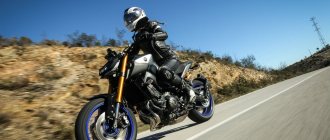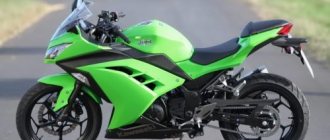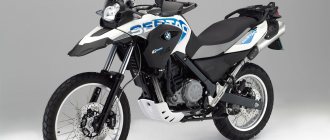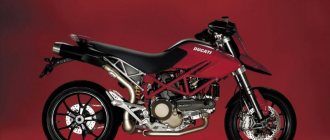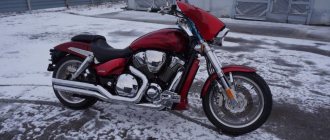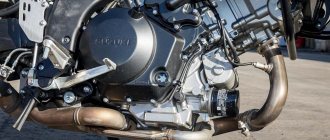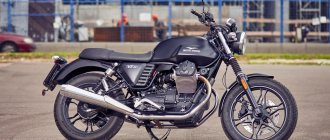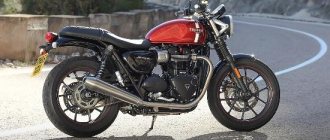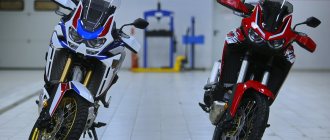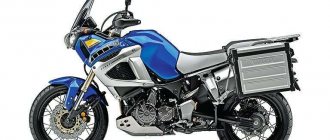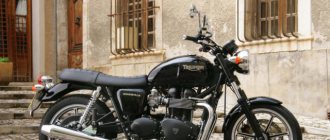Hyosung GT650R:
2014, 647 cm3, 74 l.
pp., 215 kg, 399,000 rub. (2017) text: Alexander Barkalov photo: Nikita Kolobanov
in the photo: Alexander Barkalov
»The GT650R model from the Korean manufacturer Hyosung fits quite well into the concept of an inexpensive, reliable and attractive motorcycle for every day. Despite the presence of serious shortcomings, the device has enjoyed good success among consumers for many years. In 2013, the GT650R underwent another restyling... but only test tests will show whether the new motorcycle is better.
Hyosung Motorsand Machinery was founded in Korea in 1978. A year later, the plant signed an agreement on cooperation and collaboration with the Japanese company Suzuki Motors. Since then, the Koreans have been closely involved in the production and sale of motorcycles under their own brand, successfully combining copied Suzuki components and components of their own design in their design.
The history of the GT650 model goes back to 2004, when Hyosung specialists developed their 650 cc V-Twin based on the Suzuki SV650 engine. It was around this engine, renowned for its reliability and decent performance, that the first generation GT650R Comet was built. Since then, the Hyosung road sport bike family has undergone a few minor facelift surgeries, but overall the GT650 remains as close to the original as possible.
Despite the company’s eloquent press releases dedicated to the release of the updated version of the GT650R and presenting it as nothing less than a new model, there are not many changes in the design of the motorcycle, and they are mostly purely cosmetic. The main innovation is the redesigned front fairing.
During the facelift of the front part, the shape of the air intakes was changed, which are now barely noticeable. In addition, the headlight acquired a diamond-shaped outline, which not only benefited the appearance of the motorcycle, but also gave it a little Italian touch in the spirit of the MV Agusta F4 or Bimota Tesi.
The Koreans also slightly refreshed the dashboard by adding a block of indicator lamps and changing the color of the backlight. At first glance, the innovations are minimal, but not a trace of the former archaism remains - the dashboard has become much more pleasant to use. Actually, this is where the list of innovations found in the Hyosung GT650R 2013 model year can be considered complete.
Inexpensive sportbike
Hyosung GT650R is a sports motorcycle with an engine displacement of 647 cm3. This is currently the largest cubic capacity produced by S&T Motors. The Hyosung GT650R motorcycle is very popular among novice motorcyclists who want their first “horse” to be a sport. The motorcycle can accelerate to good speeds, but is still quite leisurely, like a street in the guise of a sport. At the same time, it costs little: its price on the secondary market starts from 150,000 rubles. Finding spare parts is also not a problem. In Europe, the motorcycle is popular; it is often chosen by those who want not only high speeds, but also comfort when traveling over long distances; in addition, when purchasing a new motorcycle, the manufacturer gives a two-year guarantee.
In the original, it is available in only three colors: red, white and black, but you can buy plastic with a different design solution separately.
To be and to seem
The updated lines not only refreshed the silhouette of the Korean motorcycle, but also made its appearance even more similar to its sports counterparts from Japanese and European manufacturers. To be fair, it’s worth saying that the Hyosung GT650R has only a little more “sportbike” flavor than a grocery cart from the nearest supermarket.
Of course, developed plastic fairings, clip-ons installed under the upper crossmember, and an impressively sized muffler carefully create the image of an uncompromising thunderstorm on race tracks and night streets. But this is the case when appearances are deceiving. Once behind the wheel of a GT650R, you don’t immediately realize that this is an ordinary “road bike”, hiding under the guise of a sportbike.
It seems that the steering wheel is not set too high, and the footrests, which have several height adjustments, also force you to bend your legs decently at the knee joint, deeply “packing” your limbs into the stampings on the tank... And only a desperate masochist would call the harsh seat a sybarite’s dream! It would seem that all the signs of a real sportbike are present, but the thought that they are persistently trying to mislead you cannot get out of your head. And the very first meters in motion put everything in its place.
The upper traverse, without a single hole, looks monumental and must weigh an indecent amount. However, superhero figures as a key fob on the ignition key neutralize any shortcomings of the motorcycle. The instrument panel is simple and concise: a dial tachometer, a digital speedometer and two “columns” informing about the fuel level and engine coolant temperature.
As soon as the motorcycle starts moving, all the pseudo-sportbike attributes fade in the shadow of the V-shaped “deuce” from the late 90s of the last century. The characteristics of the V-twin engine installed in the steel frame of the GT650R are so average and universal that Hyosung even installs it on the GV650 Aquila cruiser!
A licensed copy of the Suzuki SV650 engine produces 74 hp. s., which by modern standards, frankly speaking, is a rather modest value. The engine characteristics look especially detrimental when compared with the performance of modern 600 cc sportbikes, the power of which does not fall below 100 hp. With.
However, if you mentally come to terms with the fact that underneath you is not a sports vehicle, but only a “packed” road bike, then the capabilities of the 2-cylinder engine no longer look so depressing.
The torque produced by the engine is quite enough to quickly accelerate at any time, without switching to a lower gearbox level. The V-twin pulls confidently from just 3,500 rpm right up to the limiter, delivering smooth but punchy acceleration.
The well-worn 647 cc “two” also has its own characteristics: as soon as the tachometer needle crosses the 6000 rpm mark, the engine begins to vibrate furiously, transmitting a tremor to the steering wheel and footpegs. At first you don’t pay attention to this feature, but after 30 minutes of vibromassage procedures there is a strong desire to stop and take a breath.
For testing, I received a Hyosung GT650R with a clearly “sick” engine: at about 5000 rpm, the tachometer needle froze for a split second, and the power unit interrupted the transmission of traction to the rear wheel. A seemingly trivial flaw in the slow corners of the karting track threatened to end in an inevitable fall, which made driving the GT650R even more exciting. However, there is no doubt that this “bug” is typical for this particular motorcycle, since no similar problems were found on the ST7 and GT650P models.
With a high degree of probability, even installing brake pads from a well-known manufacturer will not be able to solve the problem of ineffective brake operation - the problem is in the mechanisms themselves... However, reinforced hoses and new pads should at least slightly improve the braking system. Already in the basic configuration, the motorcycle is equipped with adjustable footrests - just like on real sportbikes! Not the most useful accessory for a road warrior, but still nice.
The tough operation of the gearbox deserves much more attention from the future owner of the GT650R: a noticeable force must be applied to the gearshift foot, and each shift, especially from the first to the second stage of the transmission, is accompanied by a characteristic sound. At first, finding a neutral gear will also require some skill, but as you get used to the features of the gearbox, this problem will solve itself.
Hyosung GT650R: technical specifications
If the first models of this company were presented with Suzuki engines, then the GT650R is a completely Korean development. The motorcycle has a two-cylinder four-stroke V-engine with a power of 79 hp. With. The cooling system is liquid, and the engine starts with an electric starter. The gearbox is six-speed. At first speed, the Hyosung GT650R accelerates to 86 km/h, and up to 134 km/h at second. The dry weight of the motorcycle is 215 kg, and the gas tank volume is 17 liters. Brakes include a 300mm floating disc with a four-piston caliper on the front wheel and a 230mm disc with a two-piston caliper on the rear. The length and height of the bike are 2090 and 1135 respectively, with a seat height of 830 inches.
The front suspension is represented by an inverted telescopic fork, and the rear suspension is pendulum with a monoshock absorber.
Ghost from the past
As a rule, a motorcycle’s belonging to the “budget” category a priori implies its simplified chassis, from which it is simply unfair to demand filigree work. In the case of the GT650R, S&T Motors, which produces motorcycles under the Hyosung brand, also did not spend unnecessarily on suspension elements.
A simple “telescope” with feathers with a diameter of 41 mm and a budget shock absorber—that’s all that the Koreans awarded their “sportbike”. But even for a budget motorcycle, the GT650R boasts a pretty decent chassis. In the city, the suspensions cope well with all the variety of uneven surfaces, also called roads.
The fork readily swallows both large holes and ledges of sewer manholes; The rear shock absorber, in turn, does not work so intelligently, often allowing breakdowns and regularly giving back to the “fifth point”. The Hyosung GT650R will also look appropriate on a karting track. The assembled chassis of the device in combination with the 160th rear wheel gives the motorcycle good handling.
Of course, the “Korean” has no trace of the lightness inherent in Japanese sportbikes or modern naked bikes: in order to dash the GT650R into corners, physical effort is required. Although, perhaps, someone will like this “forceful” method.
All of the above-described disadvantages of Hyosung, by and large, are not so critical for daily use and can be perceived by the owner of the motorcycle, rather, as features or models. The only truly serious miscalculation of the Koreans is the braking system of the device.
Despite the fact that the GT650R has 300 mm diameter discs and 4-piston calipers at the front, the brakes are, frankly speaking, very mediocre, being a true indicator of the real age of the model. I can't remember the last time I had to use more than two fingers on the lever to brake hard!
Only the rear brake of the GT650R works worse than the front one: pressing the pedal all the way resulted in a barely noticeable deceleration, so its role in braking is almost negligible. Russian Hyosung sellers do not deny the problem of weak brake mechanisms of the model, at the same time stating that the situation can be radically changed only by installing an alternative brake cylinder.
The power curve of the V-twin starts to rise from about 3000 rpm. Then, at about 5 thousand revolutions, a small dip is noticeable in the graph, which is clearly felt while driving. The next such failure is already at around 6500 rpm. The engine exhibits a peak power value of 69.7 horsepower at 7865 rpm, and then another “bend” of the curve follows. Despite the fact that the engine is capable of spinning up to 10.5 thousand, there is no need to drive the “old” power unit into the red zone - the peak values of power and torque are available in the middle part of the tachometer.
About the manufacturer
The Korean company HYOSUNG (S&T Motors) is quite young and appeared only thirty years ago. Since the company did not have its own developments, it had to establish cooperation with other manufacturing companies. After an unsuccessful attempt with Moto Guzzi, Hyosung signed a contract with Suzuki. The Koreans added their know-how to the Japanese developments they received, and then motorcycles under the Hyosung brand appeared on the market for the first time. However, the Japanese imposed some restrictions, so the company soon began to engage in its own design research, luring several Japanese engineers.
In 1988, the company became the official supplier of the Olympic Games in Seoul, and in 1994 it debuted on the European market with its first cruiser, the Hyosung Cruise 125. In the period until 2001, several more of its own motorcycles were produced. In 2007, the company was purchased by a large holding company S&T Group and received another official name - S&T Motors.
